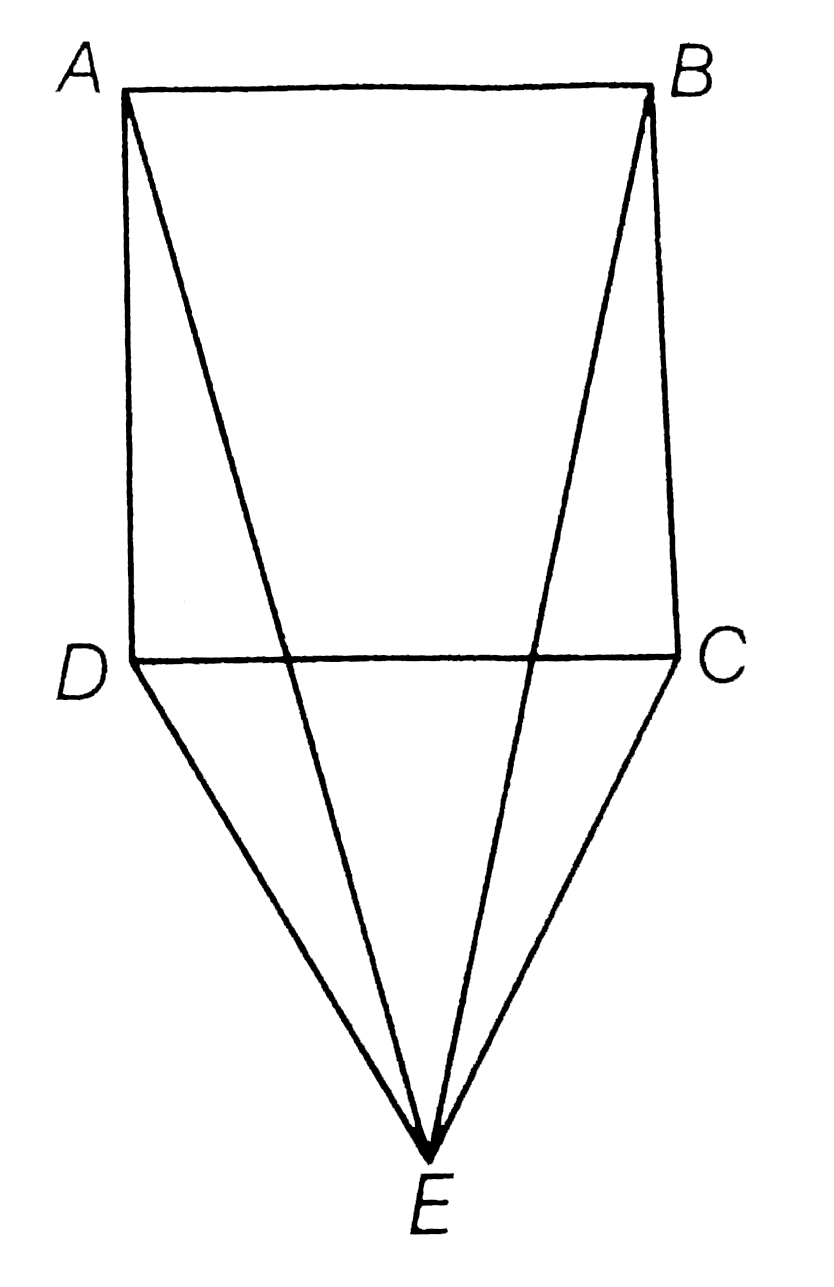ABCD is a square. Draw an equilateral triangle PBC on side BC considering BC is a base and an equilateral triangle QAC on diagonal AC considering AC is a base. Find the value of
Area of ΔPBCArea of ΔQAC.
12
1
13
14
The correct Answer is:A
To solve the problem, we need to find the areas of triangles PBC and QAC and then calculate the ratio of these areas.
Step 1: Define the side length of the square
Let the side length of square ABCD be A.
Step 2: Calculate the length of the diagonal AC
The diagonal AC of the square can be calculated using the Pythagorean theorem:
AC=√A2+A2=√2A2=A√2
Step 3: Calculate the area of triangle PBC
Triangle PBC is an equilateral triangle with side length equal to the side of the square, which is A. The area of an equilateral triangle is given by the formula:
Area=√34×side2
Thus, the area of triangle PBC is:
Area of ΔPBC=√34A2
Step 4: Calculate the area of triangle QAC
Triangle QAC is also an equilateral triangle, but its side length is the diagonal AC=A√2. Using the same area formula:
Area of ΔQAC=√34×(A√2)2
Calculating this gives:
Area of ΔQAC=√34×2A2=√32A2
Step 5: Calculate the ratio of the areas
Now, we can find the ratio of the areas of triangle PBC to triangle QAC:
Area of ΔPBCArea of ΔQAC=√34A2√32A2
Simplifying this expression:
=√34√32=14×21=12
Final Answer
The value of the ratio of the areas is:
Area of ΔPBCArea of ΔQAC=12
Let the side length of square ABCD be A.
The diagonal AC of the square can be calculated using the Pythagorean theorem:
AC=√A2+A2=√2A2=A√2
Triangle PBC is an equilateral triangle with side length equal to the side of the square, which is A. The area of an equilateral triangle is given by the formula:
Area=√34×side2
Thus, the area of triangle PBC is:
Area of ΔPBC=√34A2
Triangle QAC is also an equilateral triangle, but its side length is the diagonal AC=A√2. Using the same area formula:
Area of ΔQAC=√34×(A√2)2
Calculating this gives:
Area of ΔQAC=√34×2A2=√32A2
Now, we can find the ratio of the areas of triangle PBC to triangle QAC:
Area of ΔPBCArea of ΔQAC=√34A2√32A2
Simplifying this expression:
=√34√32=14×21=12
The value of the ratio of the areas is:
Area of ΔPBCArea of ΔQAC=12
Topper's Solved these Questions
- BOOK - KIRAN PUBLICATIONCHAPTER - MENSURATIONEXERCISE - TYPE - III21videos
MENSURATION
- BOOK - KIRAN PUBLICATIONCHAPTER - MENSURATIONEXERCISE - TYPE - IV169videos
MENSURATION
- BOOK - KIRAN PUBLICATIONCHAPTER - MENSURATIONEXERCISE - Test Yourself28videos
MENSURATION
- BOOK - KIRAN PUBLICATIONCHAPTER - LCM AND HCF EXERCISE - Test Yourself18videos
LCM AND HCF
- BOOK - KIRAN PUBLICATIONCHAPTER - MISCELLANEOUSEXERCISE - TYPE-VI15videos
MISCELLANEOUS
Similar Questions
Knowledge Check
- Question 1 - Select One
Area of equilateral triangle of side a unit is
A√32a2B√34a2C√32aD√34a - Question 2 - Select One
ABCD is a square . Draw a triangle QBC on side BC considering BC as base and draw a triangle PAC on AC as its base such that ΔQBC~ΔPAC. Then, Area of ΔQBCArea of ΔPAC is equal to :
A12B21C13D23 - Question 3 - Select One
Find the area of an equilateral triangle whose side is a cm.
A√34a2 cm2B√24a2 cm2C√35a2 cm2D√25a2 cm2
Find the area of an equilateral triangle of side 6 cm.
View SolutionFind the area of an equilateral triangle of side 6 cm.
View SolutionProve that area of an equilateral triangle formed on one side of a given square is one half of area of equilateral triangle formed on diagonal is the same square.
View SolutionA square and an equilateral triangle are drawn on the same base. The ratio of their area is
View SolutionIn the given figure,ΔCDE is an equlatel triangle triangle formed on a side CD of a square ABCD.Show that ΔADE≅ΔBCE.
 View Solution
View Solution

